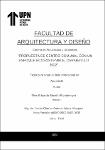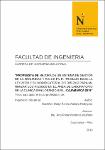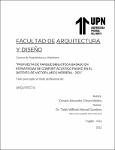Mostrar el registro sencillo del ítem
Estrategias bioclimáticas pasivas aplicadas al diseño de un centro cultural vivencial en el distrito de Llacanora para el 2020
| dc.contributor.advisor | Llanos, Alberto | |
| dc.contributor.author | Saldaña Blanco, Lizeth del Rocio | |
| dc.date.accessioned | 2020-02-18T15:31:55Z | |
| dc.date.available | 2020-02-18T15:31:55Z | |
| dc.date.issued | 2020-06-30 | |
| dc.identifier.citation | Saldaña, L. (2019). Estrategias bioclimáticas pasivas aplicadas al diseño de un centro cultural vivencial en el distrito de Llacanora para el 2020 (Tesis de licenciatura). Repositorio de la Universidad Privada del Norte. Recuperado de http://hdl.handle.net/11537/23630 | es_PE |
| dc.identifier.other | 720.284 SALD 2019 | es_PE |
| dc.identifier.uri | https://hdl.handle.net/11537/23630 | |
| dc.description.abstract | La presente tesis tiene como propósito explicar la importancia del proyecto como tal siendo ésta la respuesta a la problemática social ambiental que se está viviendo, partiendo de un análisis contexto forma en campos de acción similares como prototipos que ayuden a direccionar una propuesta acertada, propiciando así una simbiosis cultural ambiental para aprovechar tanto los recursos culturales como los recursos naturales, todo esto en pro de la mejora para la calidad de vida de la población y a la reducción de energías no renovables, instaurar un Centro Cultural Vivencial Bioclimático en el distrito de Llacanora generaría además de intercambios culturales un dinamismo económico social cultural, teniendo como valor agregado la eficiencia energética, la infraestructura actúa como un atractor que acoge diferentes tipos de usuario por un lado el usuario en la etapa de instrucción y por otro lado el turista que juega un importante papel con una postura diferente ya que éste va a formar “parte de”, parte de un aprendizaje, parte de un grupo y experimentar nuevas vivencias, si así lo desea va a dejar de ser el típico observador para ser un integrante más. El proyecto arquitectónico tiene como uno de sus conceptos prioritarios la integración medioambiental, específicamente lo que respecta a consumos, esta tendencia a la autosuficiencia implica considerar factores como los agentes externos o las denominados condicionantes climáticas y su incidencia sobre el entorno para ello se reconoce dos tipos de condicionantes, el primero que vendría a ser los condicionantes específicos del terreno donde se evalúa a los elementos próximos al área de influencia o área donde se sitúa el hecho arquitectónico como por ejemplo la vegetación y los condicionantes generales que vendría hacer los elementos climáticos o agentes. | es_PE |
| dc.description.abstract | The purpose of this thesis is to explain the importance of the project as such, and this is the response to the environmental social problem that is being experienced, starting from an analysis of the background in similar fields of action such as prototypes that help direct relevant proposals, thus promoting an environmental cultural symbiosis to take advantage of both cultural resources and natural resources, all this in favor of improving the quality of life of the population and the reduction of non-renewable energies, establishing a Cultural Center Bioclimatic Experience in the district of Llacanora would generate of cultural exchanges an economic dynamism, having as added value the energetic efficiency, the infrastructure acts as an attractor that receives different types of user on the one hand the user in the instruction stage and on the other hand the tourist who plays an important role with a different posture since this one will be "part of", part of a learning, part of a group and experience new experiences, if you want to stop being the typical observer to be a member more. This architectural project has as one of its priority concepts environmental integration, specifically with regard to consumption, this tendency to self-sufficiency involves considering factors such as external agents or the so-called climatic conditions and their impact on the environment for it is recognized two types of conditioners, the first that would become the specific conditioners of the land where the elements next to the area of influence or area where the architectural fact is located are evaluated, such as the vegetation and the general conditioning factors that climatic elements or agents would make meteorological conditions. | es_PE |
| dc.description.uri | Tesis | es_PE |
| dc.format | application/pdf | es_PE |
| dc.format | application/msword | es_PE |
| dc.language.iso | spa | es_PE |
| dc.publisher | Universidad Privada del Norte | es_PE |
| dc.rights | info:eu-repo/semantics/openAccess | es_PE |
| dc.rights | Atribución-NoComercial-CompartirIgual 2.5 Perú | * |
| dc.rights.uri | https://creativecommons.org/licenses/by-nc-sa/2.5/pe/ | * |
| dc.source | Universidad Privada del Norte | es_PE |
| dc.source | Repositorio Institucional - UPN | es_PE |
| dc.subject | Arquitectura | es_PE |
| dc.subject | Centros culturales | es_PE |
| dc.subject | Arquitectura sostenible, aspectos ambientales | es_PE |
| dc.title | Estrategias bioclimáticas pasivas aplicadas al diseño de un centro cultural vivencial en el distrito de Llacanora para el 2020 | es_PE |
| dc.type | info:eu-repo/semantics/bachelorThesis | es_PE |
| thesis.degree.grantor | Universidad Privada del Norte. Facultad de Arquitectura y Diseño | es_PE |
| thesis.degree.level | Título Profesional | es_PE |
| thesis.degree.discipline | Arquitectura y Urbanismo | es_PE |
| thesis.degree.name | Arquitecto | es_PE |
| dc.publisher.country | PE | es_PE |
| dc.subject.ocde | https://purl.org/pe-repo/ocde/ford#6.04.08 | es_PE |
| thesis.degree.program | Pregrado | es_PE |
| dc.description.sede | Trujillo El Molino | es_PE |
| renati.advisor.dni | 18143230 | |
| renati.advisor.orcid | https://orcid.org/0000-0001-7525-7669 | es_PE |
| renati.author.dni | 47064942 | |
| renati.discipline | 731156 | es_PE |
| renati.juror | Bocanegra Galván, Hugo Gualberto | |
| renati.juror | Chávez Olivos, Roberto Octavio | |
| renati.juror | Ríos Gutierrez, Diego Antonio | |
| renati.level | https://purl.org/pe-repo/renati/level#tituloProfesional | es_PE |
| renati.type | https://purl.org/pe-repo/renati/type#tesis | es_PE |
Ficheros en el ítem
Este ítem aparece en la(s) siguiente(s) colección(ones)
-
Tesis [153]








